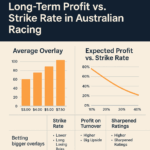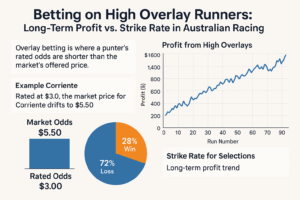In the world of horse racing, punters often face a strategic dilemma: should they chase a higher strike rate by backing favourites and short-priced runners, or pursue long-term profitability by targeting high overlay runners – those whose market odds exceed their assessed value?
This article explores the concept of overlays, compares their profitability to low or negative overlays, and evaluates which approach offers better returns in the Australian betting landscape.
 What Is an Overlay?
What Is an Overlay? An overlay occurs when a horse’s market odds are greater than the odds you’ve personally assessed based on form, conditions, and other factors. For example, if you rate a horse at $4.00 but the bookmaker offers $8.00, that’s a double overlay – a potential goldmine for value punters.
Professional punters often frame their own markets and only bet when they identify overlays. This approach is grounded in the principle that value betting, not strike rate, drives long-term profitability.
 Strike Rate vs. Profitability
Strike Rate vs. Profitability Backing favourites or short-priced runners may yield a higher strike rate, but does it translate to profit?
-
- According to Kruzey’s analysis of 46,403 Australian races, favourites win 34.9% of the time. However, backing every favourite at $1 per race would result in a net loss of $631.34.
-
- Second favourites win 19.83% of the time, and third favourites 13.49%, yet both also return negative profits over time.
This highlights a critical insight: strike rate alone doesn’t guarantee profitability. In fact, consistently backing overlays – even with a lower strike rate – can outperform favourites in terms of return on investment.
 Why High Overlays Win the Long Game
Why High Overlays Win the Long Game Here’s why betting on high overlay runners is often more profitable:
-
- Mathematical Edge: If your rated odds are more accurate than the market, betting overlays gives you a statistical advantage.
-
- Bankroll Growth: Even with fewer winners, the higher payouts from overlays can offset losses and grow your bankroll.
-
- Market Inefficiencies: Australian racing markets, especially midweek and provincial meetings, often misprice runners, creating overlay opportunities.
For example, if you rate a horse at $3.50 and the market offers $6.50, a $20 bet could return $130, yielding a profit of $110 – a substantial overlay.
The Psychology Trap: Chasing Winners
Many punters fall into the trap of backing short-priced runners for the dopamine hit of frequent wins. But professional punters focus on value, not frequency. Betting on overlays requires discipline and patience, especially during losing streaks.
 Overlay Betting in the Australian Market
Overlay Betting in the Australian Market Australia’s racing scene – with its diverse track conditions, field sizes, and bookmaker competition – offers fertile ground for overlay betting. Tools like Betfair Exchange allow punters to find better prices, and minimum bet limits ensure access to advertised odds.
Punt Form Pro provide detailed form data to assist with framing your own market, helping punters identify overlays with precision.
 Final Verdict
Final Verdict While betting on no or negative overlay runners may boost your strike rate, it rarely leads to long-term profit. High overlay betting, though less glamorous in the short term, offers a sustainable edge for disciplined punters.
If your goal is to beat the market, not just pick winners, then high overlay runners are your ticket to long-term success.
Check out our free overlay calculator.


